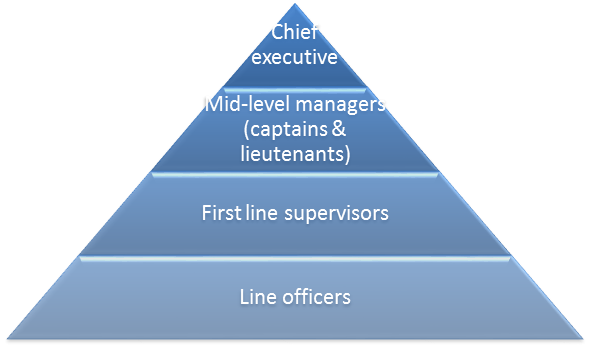Main Content
Lesson 2: TIntrodcution to Police Organization
Vertical Colmplexity
Vertical complexity refers to chain of command or the "scalar principle". Chain of command establishes a clear line of authority from the chief executive of the policing agency to all employees under him/her. Typically, communication flows downward: the chief gives and order and everyone under him/her is expected to carry it out. Imagine a pyramid structure where authority lies at the top; the chief executive makes the decisions:

The pyramid may not always look like a perfect triangle. Consider Figure 2.1 on page 22 of the Giblin textbook. The pyramid can have a wide base, with many officers and few leaders; it can be a generally wide pyramid when there are many mid-level managers; or it can morph with considerable weight at the top when there are many top executive leaders with few mid-level managers. Either shape it takes, the pyramid structure suggests top-down communication, where leaders make decisions for subordinates to implement.
One exception to the top-down communication rule is community policing. The community policing movement attempted to upend the decision-making process, giving line officers on the street more discretion to solve community concerns, as officers on the street arguably are more familiar with the intricacies of their assigned neighborhoods than further removed administrators.
Sometimes, communication can flow upward, with line officers communicating to their sergeants, who relay information to their lieutenants, who share details with the captains and so on until the chief executive is informed. In this way, the chain of command can provide a two-way street for information.
Aside from communication, there are several unofficial hierarchies present in policing organization, including those based on skills, rewards, status and seniority.
References
Cordner, G. W. (2016). Police Administration (9th ed.). New York: Routledge.
